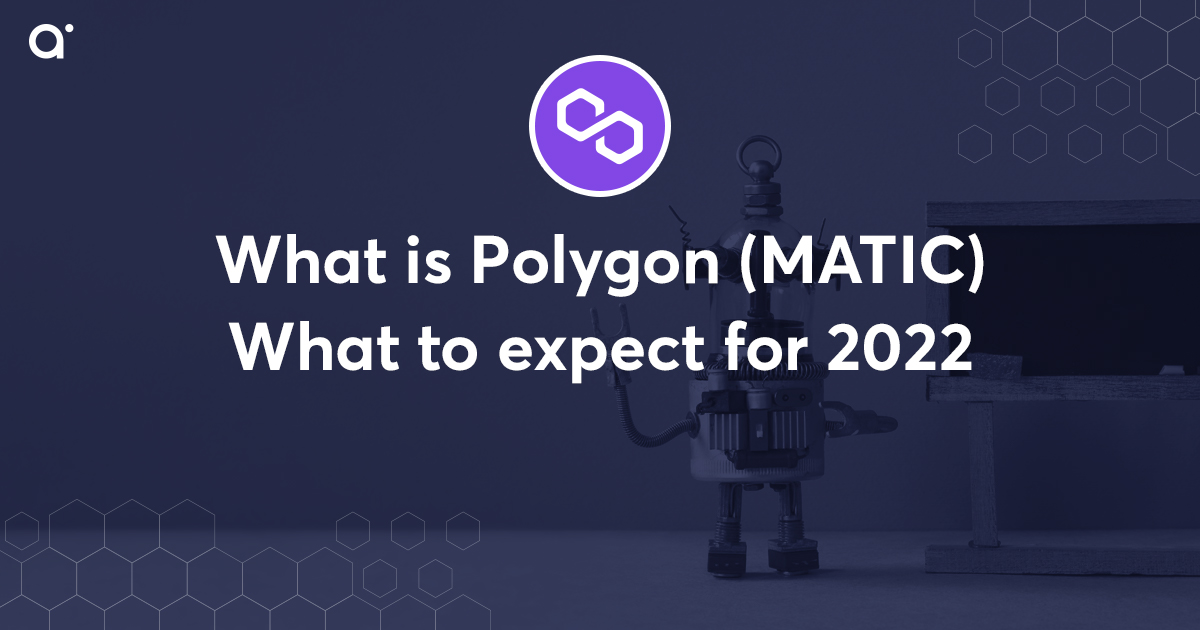What is Polygon (Matic)? – A prediction for 2022
- 5 minute read

Matic coin Is a crypto currency that has climbed to a stable top 20 coin on CoinMarketCap in just over a year. What is Polygon and what does Matic have to do with it? What is layer 2 and what can we expect from it in 2022? We take a look at today's article.

What is Matic coin?
When you look up Polygon, you will often see Matic. In addition, the abbreviation of the coin is also Matic. This can be confusing for someone who is new to crypto (or does not know the coin very well). Polygon was previously called the Matic Network and has been rebranded to the Polygon Network in the past. The coin was launched in 2017 and at the time of writing is ranked 15 on CoinMarketCap. A total of 10 billion Matic coins are coming to market, of which 75% are currently in circulation. One Matic coin has a value of $1.76 per coin at the time of writing. This is almost 40% lower than the All-time High of $2.92 per coin measured at the end of December last year.
What is the Polygon Network?
The Polygon Network is a coin built on the second layer of Ethereum . The coin was conceived by three Indians named Jaynti Kanani, Sandeep Nailwal and Anurag Arjun. They wanted to help solve the problems Ethereum is facing. In particular, the low speed of 30 transactions per second (TPS) was a reason for the developers to come up with a solution. Competitors such as Cardano (257 TPS), Polkadot (1,000 TPS) and Solana (65,000 TPS) are much faster than Ethereum. Because the transaction speed is low, the costs for a transaction are very high at busy times. For example, you can pay over $100 in transaction fees for sending Ethereum during busy periods.
The problem with the Ethereum network is the fact that all applications work through that same Ethereum network. So these applications automatically take over the minus points, in this case the transaction costs. The solution to this problem: the Polygon Network. The network is a 'Layer-two (L2)' protocol and is a platform built to scale. This is made possible by using sidechains, enabling off-chain transactions. The transactions are validated by using the Proof-of-Stake algorithm. Polygon uses Ethereum Virtual Machine (EVM), which in other words is a code managed by computers around the world to enable the execution of smart contracts. Smart contracts are online contracts that conclude an agreement between parties.
The solution has allowed dApps (decentralised application) built on the Ethereum blockchain to run on Polygon's network, allowing them to take advantage of the scalability. Polygon's network can handle around 10,000 transactions per second, making it a lot cheaper than Ethereum. You pay less than one cent for a transaction on the Polygon network.
Polygon in the NFT world
As many will know, the Ethereum blockchain is widely used for the creation (minting) and trading of non-fungible tokens (NFTs). An NFT is a smart contract that is unique in itself and is often used to register digital art on the blockchain. The Ethereum blockchain is currently the most widely used platform for registering and trading NFTs. Trading NFTs is often done on trading platforms such as Opensea and Rarible. As mentioned before, the transaction costs on the Ethereum blockchain are high and therefore, mining and trading NFTs on the Polygon network is much cheaper. The low transaction costs are a good reason for artists to register their digital artworks on the Polygon network. In terms of popularity, Polygon has a lot of catching up to do and this is reflected in the fact that in the top 100 largest NFT projects on Opensea, there is not a single Polygon NFT to be found.
20 Legendary Dorkies in #PolygonNetwork looking for their owner
— Dorkie WTF (@dorki_wtf) February 13, 2022
Mint at ➡️ https://t.co/qB0sMYWPND #NFTs #NFTartist #Polygon #MATIC #OpenSeaNTF #DorkieWTF pic.twitter.com/3oWvIMKB7G
Polygon Expectations 2022
In 2022, Polygon is expected to make several upgrades. For example, the network will launch public test nets and Polygon will collaborate with Norwegian internet browser Opera. The collaboration is an integration of Polygon on the Opera browser. The collaboration will allow Opera browser users to use thousands of dApps in the browser, expanding the browser's functionality. Polygon will also partially follow the upgrade made by Ethereum. Namely, the strengths from the upgrade EIP-1559 will be implemented. This upgrade will enable the burning of tokens, making the destruction of Matic coins possible. It is difficult to say what impact the upgrades will have on price development, but the developments show that Polygon Network continues to evolve.
Opera will integrate @0xPolygon dapps and MATIC in its browser in Q1 2022! 🚀 Get ready to benefit from the fast, scalable & low fee environment and access over 3,000 DApps on the Polygon network. Learn more: https://t.co/EK3Y9ZPreq pic.twitter.com/0pEf7PafGB
— Opera (@opera) December 22, 2021
Conclusion
Polygon Network has been an innovation on the Ethereum blockchain. The network has made it possible for protocols to scale up the Ethereum blockchain, increasing the speed of these protocols and reducing the cost. The price of Matic coin has gone to a record high of $2.92 per coin in the past year. This is over 40% more than its value at the time of writing. However, upgrades are planned for 2022 that should help the network. What this will do to the price is hard to say, but the network shows that they continue to develop themselves.
Check out our cryptocurrencies overview


